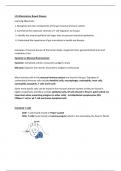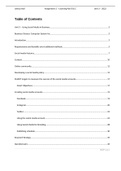Lecture notes
IBD Lecture notes: Immunology of Human Disease (6BBBI308)
- Institution
- Kings College London (KCL)
These lecture notes on Inflammatory Bowel Disease (IBD) provide a comprehensive overview of the pathophysiology, clinical presentation, and treatment strategies for IBD, including Crohn’s disease and ulcerative colitis. The notes cover the immune system’s role in disease progression, key molecu...
[Show more]




